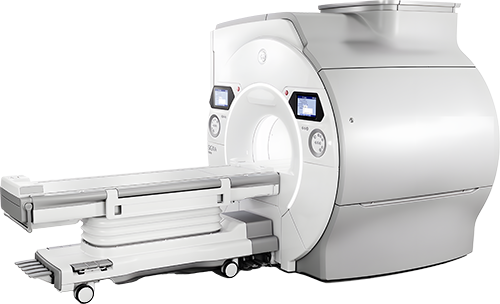MRI Imaging
What is an MRI?
Magnetic Resonance Imaging (MRI) uses a magnet to temporarily move hydrogen atoms within the cells in your body. When hydrogen atoms move back to their original position they emit different amounts of energy.
An MRI scanner measures this energy and creates an image of the area being scanned. This is illustrated in the image to the left. The quality of this image is determined by the strength of the magnet. The higher the magnetic strength, the better the image produced. This is why CDI only uses the most powerful MRIs available. While almost all other facilities use a 1.5T MRI, CDI only uses 3T MRI scanners. This means that our scanners are twice as strong. Twice as strong means a significant increase in the sensitivity of the scan. Increased sensitivity means it is more likely an abnormality will be seen on the MRI image.
This increased sensitivity is especially important for:
- Breast MRI
- Prostate MRI
- Small Joint MRI – this 3T MRI sensitivity will eliminate your need for a painful arthrogram.
While all MRI scanners are noisy and a bit claustrophobic, CDI cares about your comfort. Both of CDI’s 3T MRI scanners have the largest available bore size (the bore is the donut-shaped tube where you will be placed). These scanners are also at least twice as fast as other MRI scanners, significantly decreasing the amount of time in the scanner. With most scans you are in and out of the MRI in less than half of the time of a typical MRI scanner.
| Typical MRI | Our MRI | |
|---|---|---|
| Prostate | 60 minutes | 20 minutes |
| Joints | 45 minutes | 10-15 minutes |
Prostate MRI
| Typical MRI | Our MRI |
|---|---|
| 60 minutes | 20 minutes |
Joint MRI
| Typical MRI | Our MRI |
|---|---|
| 45 minutes | 10-15 minutes |

Why Did My Doctor Order an MRI?
MRIs are used to provide detailed information about tissues and organs in your body. Here are a few reasons your doctor may have ordered an MRI scan.
- MRI of Abdomen
This scan is used to evaluate the liver, kidneys, spleen, bowel, pancreas and adrenal glands. - MRI of Pelvis
This scan is used to evaluate the bladder, prostate and reproductive organs. - MRI of a Joint
This scan is used to evaluate injury to a joint such as a knee, ankle or shoulder. Since CDI uses a 3T MRI, your doctor will not need to order an arthrogram to see small tears in joint tissue. Arthrograms can be a very painful procedure for most patients. - MRI of Breast: This scan is used to evaluate the breast for the presence of cancer. See Breast MRI page for more information.
This is only a very short list of reasons why your doctor may have ordered an MRI scan.
Your doctor will determine if contrast should be used during the MRI. If contrast is needed, a technologist will start an IV and the contrast will be injected into your vein. The contrast agent that is used is called gadolinium. You can find out more about this drug by visiting this site.
What Should I Expect?
Before the exam, a technologist will call you to provide instructions about eating and drinking before your scan. When you arrive, a technologist will ask you questions about your symptoms and determine if you have any metal inside your body. If you have an implant such as a pacemaker, the technologist will determine if it is MRI compatible. Most implants are MRI compatible. You will be asked to remove all jewelry and any metal containing objects. You will also be asked to change into pants, or a shirt provided by the technologist. You will be provided with a private changing room where you can leave all personal items. The technologist will give you a key to this room. You can secure all personal items in this space.
No Radiation
No Pain
Noisy
How Long Will It Take?
MRI scan times differ depending on the part of the body being scanned. At CDI, areas such as joints may be scanned in as little as 10-15 minutes. Other more complex areas of the body, such as the brain, may take 30 minutes. The CDI 3T GE Hero scanner used at CDI provides the fastest scan currently available.
How Will I Get the Results?
After your scan, a board-certified radiologist will read the images produced from the scan. The radiologist will prepare a report that will be sent to your doctor. Your doctor’s office will contact you with the results.
You Get to Choose
Switching your imaging to CDI is simple and will almost always mean less out-of-pocket costs to you. Choose whichever method you prefer:
For Physicians
CDI offers the following scans.
- Abdomen, Ankle, Brain, Chest, Elbow, Foot, Hand, Hip, Knee Lower Extremity, Femur, Lower Extremity Tibia/ Fibula, Neck, Orbit, Face, Neck, Pelvis, Sacrum-Coccyx, Spine (Cervical, Lumbar, Thoracic, Sholder, TMJ Joint, Upper Extremity, Wrist, Forearm.
- MRA-MRI Angiogram: Abdomen, Aorta, Brain, Carotids, Aorto-Iliofemoral Runoff
- MRCP
- MR Enterography
- Breast and Prostate
Patients up to 500lbs can be scanned.
Because CDI is a small facility, our negotiated allowable rate for third party payors is less than big box facilities.
This means the out-of-pocket percentage required by the patient is much less.
Contact Us
The friendly, professional CDI staff is here to help. Don’t hesitate to reach out with questions, concerns or help transferring imaging orders to us. We’ll make it easy.